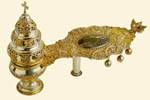|
|
| Byzantine Minor Arts |
19th c., 2nd half Dionysiou Monastery Silver, parcel-gilt and niello 26 x 40.5 cm Mount Athos |
|

|
Lanceolate leaves in flat relief, typical of the neo-classical style, decorate the bowl in which the incense is burnt, and which rests on a round base decorated with similar motifs. The tall lid, surmounted by a cross, has an undulating surface on which undecorated areas alternate with fret-works of floral sprays. The broad plate forming the handle has a cylindrical support which terminates in a cherub sculpted in the round, holding a small round bell - one of a total of seven on the katzi. In the centre of this plate is an appliquι oval medallion, with a niello-highlighted miniature of the Birth of John the Baptist, the saint to whom the katholikon of the Monastery of Dionysiou is dedicated. St Elizabeth is depicted sitting on a canopied bed, beside a table ready laid. On the left, Zacharias, 'dumb and not able to speak', is writing on a tablet the name of the new-born child who, wrapped in swaddling clothes, is held by a serving-maid. In the background are the maids in attendance on Elizabeth. The medallion is framed by a lush relief border of acanthus leaves and floral sprays. A bust, worked in relief, of John the Baptist holding a staff in the shape of a cross ornaments the end of the plate. The katzi, a type of censer with a handle instead of suspended from chains, is found in paintings of funerary scenes from the middle Byzantine period on; this particular example is typical of those made in the mid-eighteenth century. It is used mainly in monasteries, by the brother in charge of the church, on occasions prescribed by the Typikon of each foundation. This katzi from the Monastery of Dionysiou is thoroughly representative of the ninettenth-century work produced on Mount Athos. Medallions with scenes rendered in miniature are frequently found on book covers dating already from the early decades of the nineteenth century and are described with the term savatia (savad = niello), since the use of niello highlights their details (Delialis 1960, no. 11, p. 206, pl. η΄). This work also illustrates the close association between engraving and silverwork, not only in their manner of rendering scenes, but also in their iconography, which often reveals a Western influence. The canopied bed (padiglione), for example, is a detail frequently found in engravings and icons of similar representations, which in turn reflect older, Renaissance interiors: in fact, in the Birth of John the Baptist or of the Virgin, one of the maid-servants is pictured carrying a basket of fruit on her head, just as on this katzi (Papastratou 1986, I, no. 139, pp. 146-7. Vokotopoulos 1990, no. 128, pp. 160-1, fig. 64. Thornton 1991, pp. 121-9, figs. 131, 126 and 35). These appliquι medallions are usually framed by small, stylized flowers, as in this example, or by a repeated foliate motif. They are encircled by ribbons and deep-cut relief work - here somewhat rigid and severe -, foliage and floral motifs - usually tiny rococo roses, a favourite Ottoman decorative theme in this period -, and combined with neo-classical features. The revival of older trends seen in European works in gold and silver in the first half of the nineteenth century, together with the rococo style which continued to enjoy an extremely long-lived popularity, were found in the workshops of Asia Minor and the Southern Balkans with the inevitable adaptations and variations (Brett 1986, pp. 34-7, figs. 1228-9. Morsakova 1989, fig. 75. Ballian 1992 (2), no. 44, p. 84). This was a period when the craftsmen who worked in gold and silver tended to move from one district to another, which explains the pronounced resemblances between household and ecclesiastical objects in the same style as this katzi made on Mount Athos, and others from Monastir in Macedonia and Southwestern Bulgaria (Radojkovic 1974, nos. 71-2, pp. 70-1. Janc et al. 1973, no. 49, p. 34. Drumev 1976, pp. 111-12, figs. 60-1, 127-8). The Monastery of Dionysiou has a second katzi, identical to this one.
| |
|
Bibliography: Unpublished.
| ||
| Y. I.-P. | ||
| Index of exhibits of Monastery of Dionysiou 19th century |
||
Reference address : https://www.elpenor.org/athos/en/e218ci55.asp